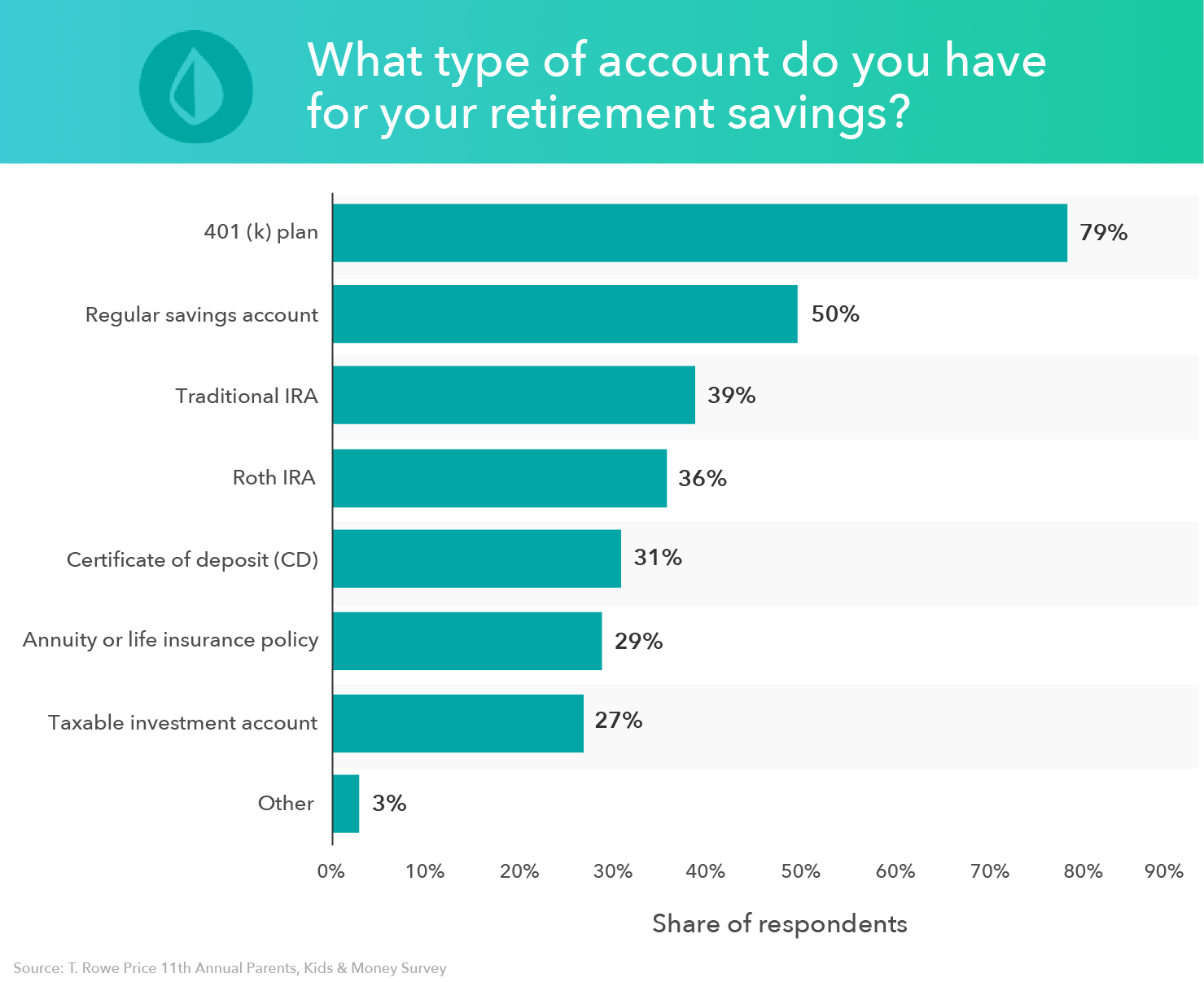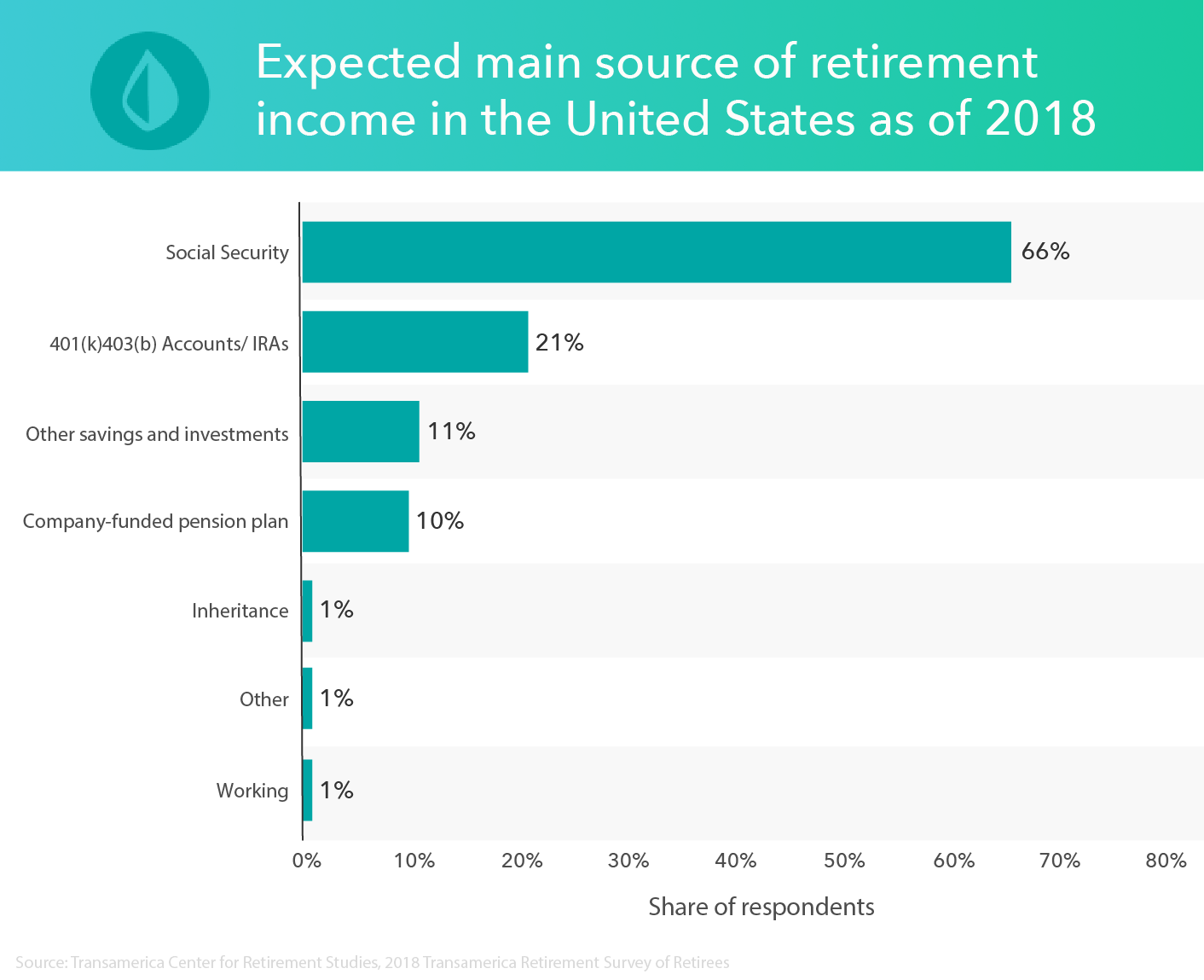Golden years require some gold.
Are you saving for retirement? You should be, even if your golden years are more than half your lifetime away. The sooner you begin, the less you’ll need to save each month.
Too many people have no idea how much they’ll need to live comfortably through retirement. According to the 19th Annual Transamerica Retirement Survey, 46 percent of respondents guessed how much money they’ll need to live comfortably in retirement. In contrast, only 22 percent made their estimate based on their current living expenses.
It’s never too late to start saving, and it’s also never too early. But you’ll need a budget to show how far you’ve come and where you’re headed. Learning how to start saving for retirement is important for everyone. There are plenty of ways you can save for retirement—401(k) accounts, IRA accounts, savings accounts, and so forth.
Below, we’ll go over how to save for retirement, the best way to save for retirement, when to start saving for retirement, and more. You can use the list below to jump to a section you’re curious about, or you can read through for a more thorough understanding of saving for retirement. Take a look!
Step One: Calculate How Much Retirement Savings You’ll Need
Expenses might not be the same at retirement. Maybe your home will be paid off by then, but the cost of living will certainly be higher. If you want to travel, you’ll need more savings. Calculating retirement funds takes a lot of consideration. The safest approach is to err on the generous side since having more than you need can never be a bad thing.
When it comes to saving money for retirement, it’s a good idea to start by differentiating your wants and needs. Sure, a Masserati and beachfront property sounds like a great way to enjoy your sunset years, but will you have enough money to pay for utilities, property taxes, and food?
The Department of Labor estimates that you need roughly 70 to 90 percent of your preretirement income to live comfortably in retirement. Budgeting for retirement can help you determine how much money you need to have saved in order to live comfortably and maybe even splurge on something new, like a vacation to Europe or a pontoon boat for the lake.
Start your retirement fund by determining your retirement savings goals. Retirement savings calculators, such as the one made by Kiplinger, does most of the work for you. It includes fields to include the amount you are scheduled to receive in Social Security benefits and investments. Fill in the blanks, and the calculator shows their estimated amount that you’ll need to have in your retirement savings.
Other ways to determine your retirement savings goals include consulting with a financial advisor, filling out a budgeting worksheet, or enlisting the help of an online budgeting tool, like the Mint app.
Different Retirement Accounts
As you calculate how much retirement savings you’ll need, it’s essential to know your options on where to save your money. Many experts suggest you save at least 15 percent of your pre-tax income every year in order to have the recommended 70 percent replacement rate.

Many retirement accounts place limits on how much you can save up each year, but there are a few different retirement accounts where you can contribute 15 percent of your salary annually.
- 401(k): A 401(k) is a retirement account that’s set up by an employer that allows workers to contribute a portion of their wages to the account. Earnings made through a 401(k) account aren’t taxed until they are withdrawn in retirement. Some employers also offer a 401(k) match, where they will match all, or a portion of your contributions.
To get the most out of your 401(k) plan, invest up to the match and aim to reach the contribution limit—as long as you can do so comfortably. The annual contribution limit in 2019 is $19,000. If you’re 50 years or older, you’re granted a catch-up contribution of $6,000, meaning you can contribute $25,000 to your 401(k).
- Traditional IRA: A Traditional IRA is a retirement account that allows you to make contributions that will be deducted from your taxes during that year. Once you withdraw money from your Traditional IRA during retirement, you will have to pay income taxes.
Each year, you can contribute up to $6,000 to your Traditional IRA, and $7,000 if you’re 50 years old or older. To get the most out of your retirement savings, aim to reach the contribution limit.
- Roth IRA: A Roth IRA and Traditional IRA are very similar. The main difference is that with a Roth IRA, your contributions aren’t deductible during the tax year you make the contribution. However, this means that when you withdraw funds from your Roth IRA in retirement, they won’t be taxed.
As with a Traditional IRA, the contribution limit for 2019 is $6,000 and $7,000 if you’re aged 50 or older. Aim to contribute $6,000 to get the most out of your retirement.
Contributing 15 percent of your annual salary towards retirement savings may seem like a daunting task at first, but you may be closer than you think.
If you contribute 5 percent of your salary to your 401(k) and your employer provides a 5 percent match, you’re already at 10 percent. And if you’ve reached the contribution limit for your Traditional or Roth IRA and still haven’t reached 15 percent, you can go back to your 401(k) and contribute the rest there, as long as you don’t exceed $19,000. If you have an old 401(k) account, you can also get an IRA rollover and put those funds into an IRA account while maintaining the tax-deferred status of your investments.
How Much Money You Should Have Saved by Age
The most pressing question many people have is when to start saving for retirement. Remember, as we previously said, it’s never too late or too early to plan for retirement. The best way to save for retirement, however, is to begin early. This means you won’t have to contribute as much money later on in life.
Here’s how much your retirement savings should be by age, according to a report by T. Rowe Price:
- Age 30: ½ times your salary
- Age 35: 1 times your salary
- Age 40: 2 times your salary
- Age 45: 3 times your salary
- Age 50: 5 times your salary
- Age 55: 7 times your salary
- Age 60: 9 times your salary
- Age 65: 11 times your salary
Step Two: Create a Budget to Save for Retirement

Retirement calculators usually produce an enormous dollar amount. Replacing 80 percent of a modest yearly salary might require a million dollars in savings or much more if there are no other anticipated sources of income. That’s a lot of savings, but spreading it out over many years means your monthly contribution won’t be as much.
A retirement calculator can assist you with saving for retirement. To create a budget to save for retirement, keep these factors in mind:
- Fixed expenses: These are recurring expenses that don’t change. Examples of fixed expenses include rent, monthly bills for services like cable, gym memberships, and cell phones, along with insurance and taxes. Knowing the fixed expenses you’ll have during retirement will allow you to calculate how much money you’ll need to get by.
- Leisure: Retirement is a time for you to pursue your passions and hobbies. Whether it’s traveling the world or picking up golf, set aside an estimate for how much money you’ll need for fun and hobbies.
- Medical costs: Unfortunately, with old age comes an increased probability of health concerns. If you retire before 65 when you’re eligible for Medicare, you may have to pay for your health insurance. Make sure you create an emergency fund for medical expenses in case any health concerns pop up.
Once you have all of your expenses tallied up, you’ll be able to determine how much money you’ll need for retirement.
Now’s the time to find extra money in your budget to devote to retirement, but sometimes there doesn’t seem to be anything left after the bills are paid. That’s where budget software, such as Mint.com products, can help.
By opening an account and entering all of your financial information, Mint products can help you find money and suggest ways to allocate it to savings. For example, an overview of your expenses and income might reveal an imbalance that you can correct.
Mint.com can expose spending patterns that you weren’t aware of, and show you how they add up monthly. Mint can also make suggestions if you’re spending too much in interest based on another lender or credit card that offers a lower rate. Every penny you find can turn into valuable retirement savings.
Now is the best time to get on track.
Step Three: Consider Investments to Supplement Retirement Savings
As the old saying goes, your money should work for you. Putting money in a cookie jar leaves exactly the amount saved. In an interest-bearing savings account, there could be slightly more over time. If you really want to watch your money grow, think about investing.

Investments always carry risk, but some are much riskier than others. When you are young, those chances are easier to take. There are still years ahead to recover from stock market drops and other losses. As you grow closer to retirement, you might consider switching to less risky investments to keep your money safer.
Additional Tips for Saving Money for Retirement
Contributing money to employer-sponsored 401(k) plans and IRAs aren’t the only options you have for saving money for retirement. Aside from investing your money, you can make a few lifestyle changes to increase your nest egg. Dol.gov offers an excellent publication on planning for retirement with worksheets and information on budgeting for retirement and tracking down expenses.
Additional steps you can take to save money for retirement include:
- Tracking your spending: With a budgeting app like Mint, you can track your spending to see where your money is going. Avoid spending money on non-essential items, such as going out to a fancy dinner every night or subscribing to every streaming service offered online. You’ll be surprised how much you can save by eliminating impulse buys and expensive services.
- Taking advantage of your health savings account (HSA): If your employer offers a high deductible health plan (HDHP) that comes with an HSA, you may consider contributing up to the contribution limit of $3,500 (individual) or $7,000 (family. Why? HSAs can cover your current and future medical costs, and funds go straight from payroll to your account. HSA contributions are also pre-tax and tax-deductible, meaning when you make a withdrawal for a qualified expense, you won’t be taxed.
- Paying off your debts: Being in debt can cost you a lot of money. Not only is the principal balance something to worry about, but the interest you accumulate can be harmful, too. Paying off your debts as soon as possible, such as credit card debt, your mortgage, student loans, and auto loans will allow you to put more money towards retirement rather than compounding interest.
Key Takeaways on Saving for Retirement
- Many Americans aren’t fully prepared for retirement and don’t have enough money saved up to live comfortably after they retire.
- It’s recommended to contribute at least 15 percent of your salary every year to your retirement accounts.
- The best way to save for retirement is by taking advantage of the many savings accounts out there, such as 401(k) accounts and IRA accounts.
- For traditional retirement accounts, your taxable income will be reduced based on the amount of your contributions, giving you a nice tax break. Roth accounts, on the other hand, will collect taxes on your contributions when you make them but will allow you to withdraw money tax-free in retirement.
- Budgeting for retirement in advance can help you stay on track for your savings goals.
- Investing in stocks and diversifying your portfolio is a great way to supplement your retirement savings.
- Tracking your spending, taking advantage of your health savings account, and paying off your debts are additional ways you can save for retirement.
Retirement is meant to be enjoyed. Learning how to save money for retirement can help you live your retirement years to the fullest. The best way to get the most out of your retirement savings is by planning ahead and committing to those plans over the long haul.
Mint.com offers budget products that help make budgeting and saving simple, so you can be sure you’re always on top of the game.
Sign up for a free account today and see how Mint.com can help your retirement plans.
Google+
Sources:
Transamerica Institute | Department of Labor | Kiplinger | Investopedia | Center for Retirement Research at Boston College | IRS | T. Rowe Price | The Balance | U.S. Department of Health and Human Services | U.S. News and World Report |


